After a disappointing show in the Champions League, Paris Saint-Germain looked to regain their confidence through Ligue 1 match-up versus Bordeaux. Coming into the match, Bordeaux was unbeaten in their last five games across all competitions, and the encounter promised to be a good test for PSG as they continue to reintegrate Neymar back into the side.
Although PSG bossed the opening 15 minutes, it was Bordeaux who drew first blood when Ui-Jo Hwang punished PSG for some sloppy defending on a corner kick. PSG struck back via Edinson Cavani in the 25th minute and then appeared to take a one-goal lead into the break when Marquinhos scored in stoppage time, but a misplayed clearance by Sergio Rico saw the first half finish 2-2.
Bordeaux came out the stronger side to begin the second half, but PSG were eventually able to reassert their dominance through a Marquinhos goal in the 63rd minute. Kylian Mbappé then added a fourth six minutes later to give PSG a two-goal lead. Bordeaux struck back through Rubén Pardo with seven minutes remaining, but it was little more than a consolation goal as PSG opened a 13-point advantage atop Ligue 1.
This tactical analysis will examine the tactics of PSG and Bordeaux and provide analysis as to why PSG prevailed 4-3.
Lineups
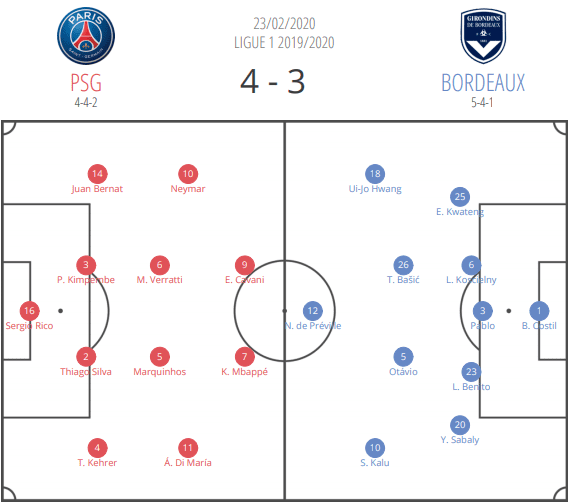
With Neymar back in the side, Thomas Tuchel opted to begin the match in a 4-4-2 formation. Juan Bernat, Presnel Kimpembe, Thiago Silva, and Thilo Kehrer marshalled the backline with Marquinhos and Marco Veratti shielding them as a double pivot. The flanks featured Ángel Di María on the right and Neymar on the left, while Edinson Cavani joined top-scorer Kylian Mbappé in the forward line.
In an attempt to limit PSG’s attacking arsenal, Bordeaux began the match in a 5-4-1 formation. Loris Benito, Pablo, and Laurent Koscielny started at centre back with Youssouf Sabaly and Enock Kwateng stationed at left and right wing-back respectively. In midfield, Bordeaux started Samuel Kalu, Toma Bašić, Otávio, and Ui-Jo Hwang, and Nicolas de Préville rounded out the side as the lone striker.
PSG’s control
PSG dominated the early stages of the match, and one reason for this was their attacking structure. To accommodate the qualities of Neymar, Di María, Cavani, and Mbappé, Tuchel had PSG build their attacks in a 4-2-2-2 formation. To create this shape, Bernat and Kehrer advanced slightly higher, Neymar and Di María drifted inside from the flanks to play between the lines, and Mbappé and Cavani split to take up positions next to either outside centre-back as shown below.
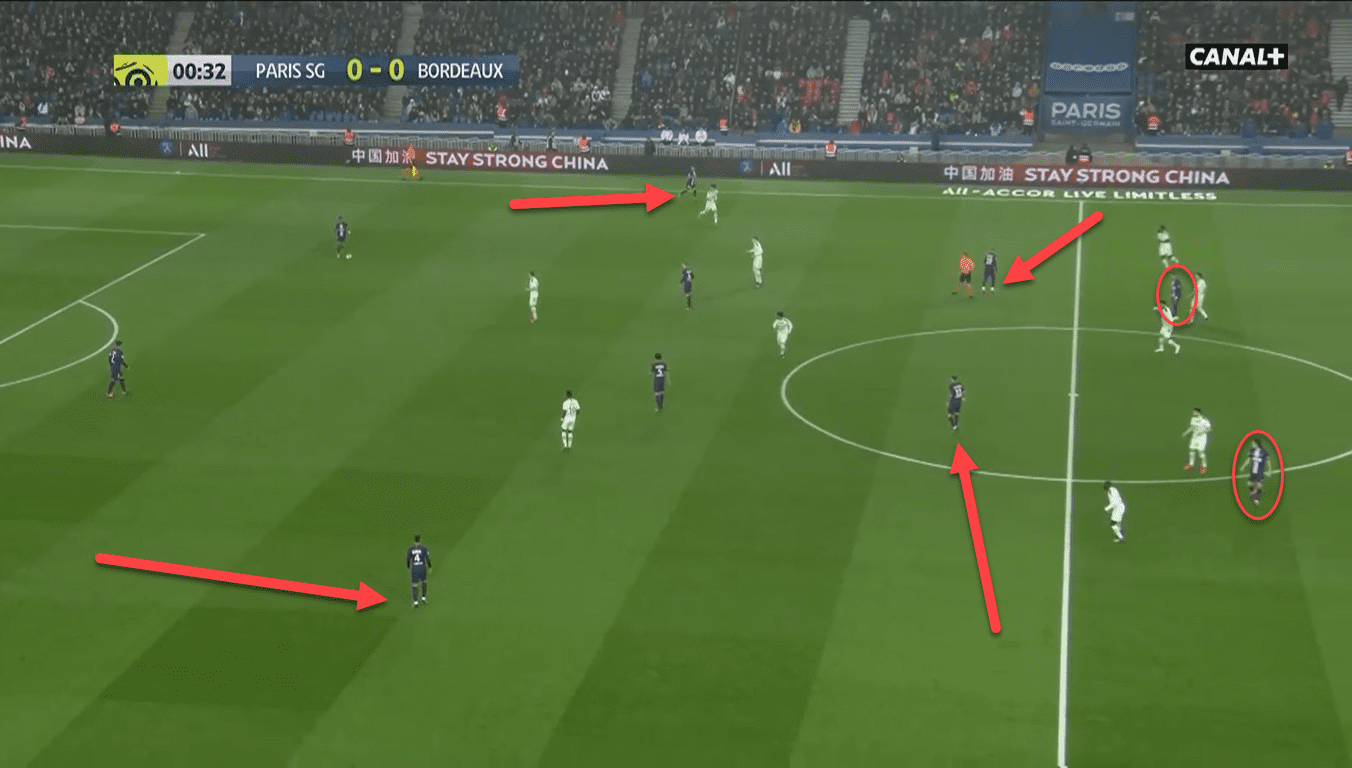
One of the keys to this formation was the positioning of Cavani and Mbappé. By placing the strikers in the gaps between the centre-backs and wing-backs, Cavani and Mbappé occupied all 5 players in the Bordeaux backline. This was because the centre-backs had to monitor both strikers and the wing-backs were reluctant to step out of the backline because doing so would create space in the channel for the pace of Mbappé and Cavani. Consequently, there was space available for Neymar and Di María between the lines, and the pair could choose between opening wide to receive or drifting inside to exploit the space as an outside back maintained the width.
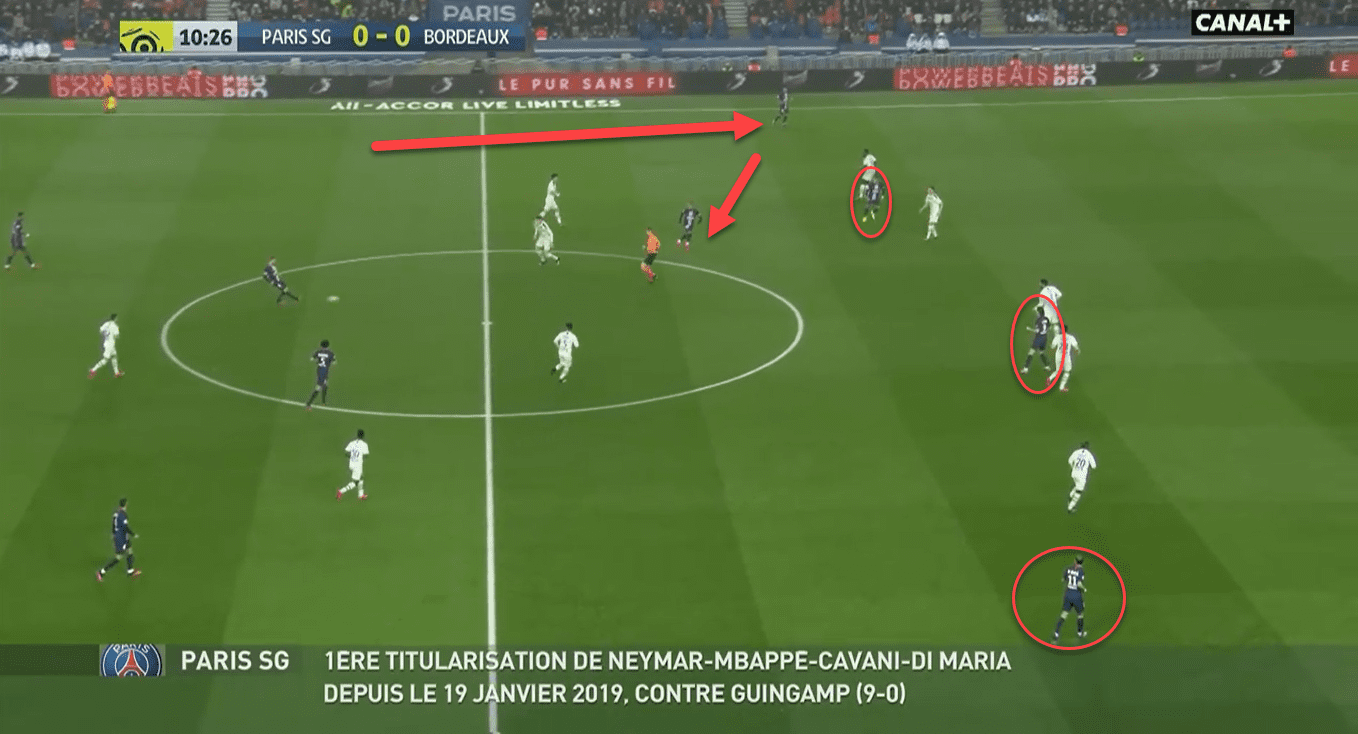
Neymar, in particular, tended to drift back to the ball and began pulling the strings in midfield, although the Brasilian found it somewhat strenuous in the first half to break down Bordeaux’s 5-4-1.
Another reason why PSG were able to dictate the match was because of their counter-pressing. As they attacked, PSG would often situate their central midfielders in supporting roles and their backside outside back tucked inside to be within 10-12 yards of Bordeaux’s backside winger. Because PSG constructed most of their attacks through Neymar on the left side, this typically resulted in Kehrer pinching inside as shown below.
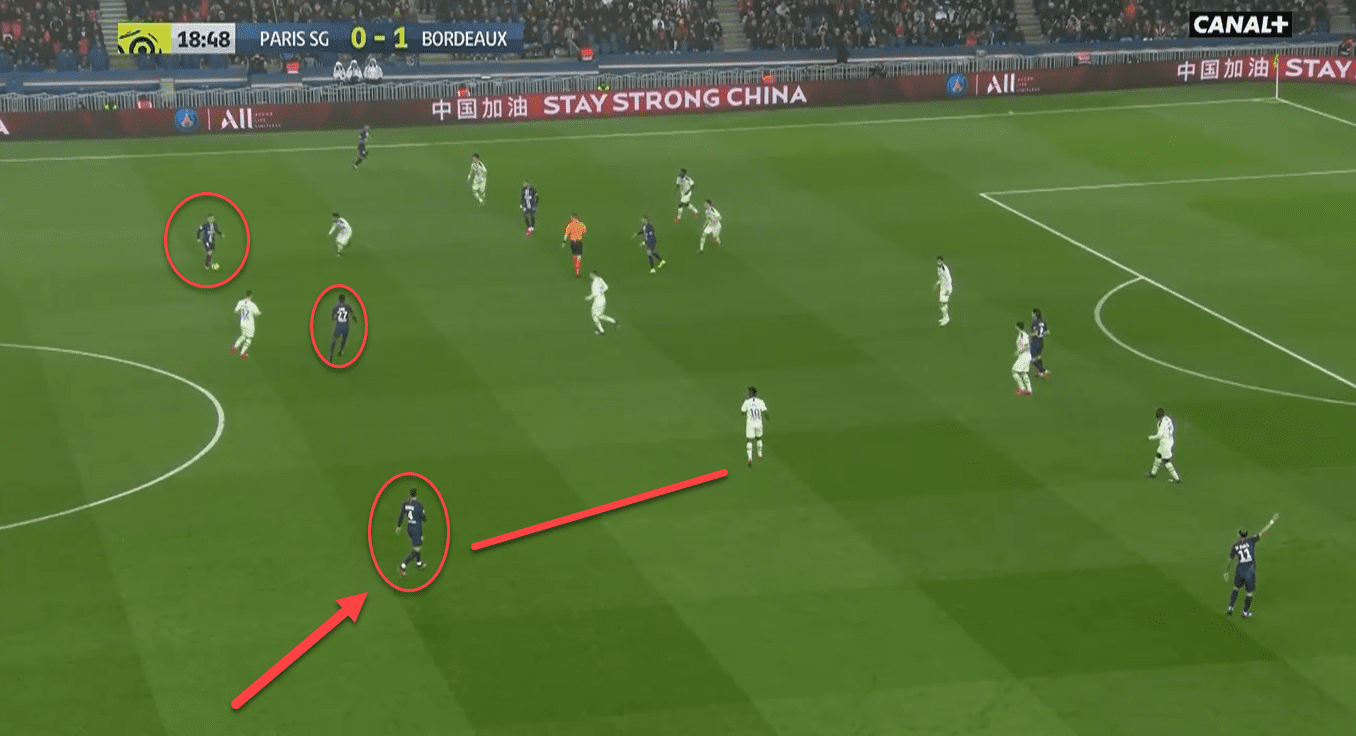
The value of this tactic was that when PSG lost possession, all three players were in position to suffocate any Bordeaux counterattacks. On the night, PSG were particularly effective in this phase, with only 50% of Bordeaux’s attacks even reaching PSG’s half.
Bordeaux’s defensive issues
Despite PSG’s control over the early proceedings, Bordeaux were able to take the lead against the run of play in the 18th minute. Nevertheless, PSG continued to advance, and it seemed only a matter of time before the Parisians would equalise. As previously described, this was partly due to the quality of PSG’s attacking play and counter-pressing. However, much of it had to do with defensive problems on behalf of Bordeaux. For instance, one issue Bordeaux had was that as they moved through various phases of the game (particularly the transition from attack to defence), their defensive block became stretched with some players pressing and some players dropping. This resulted in situations like the one shown below in which Bordeaux were outnumbered in their press and PSG were able to easily bypass any pressure.
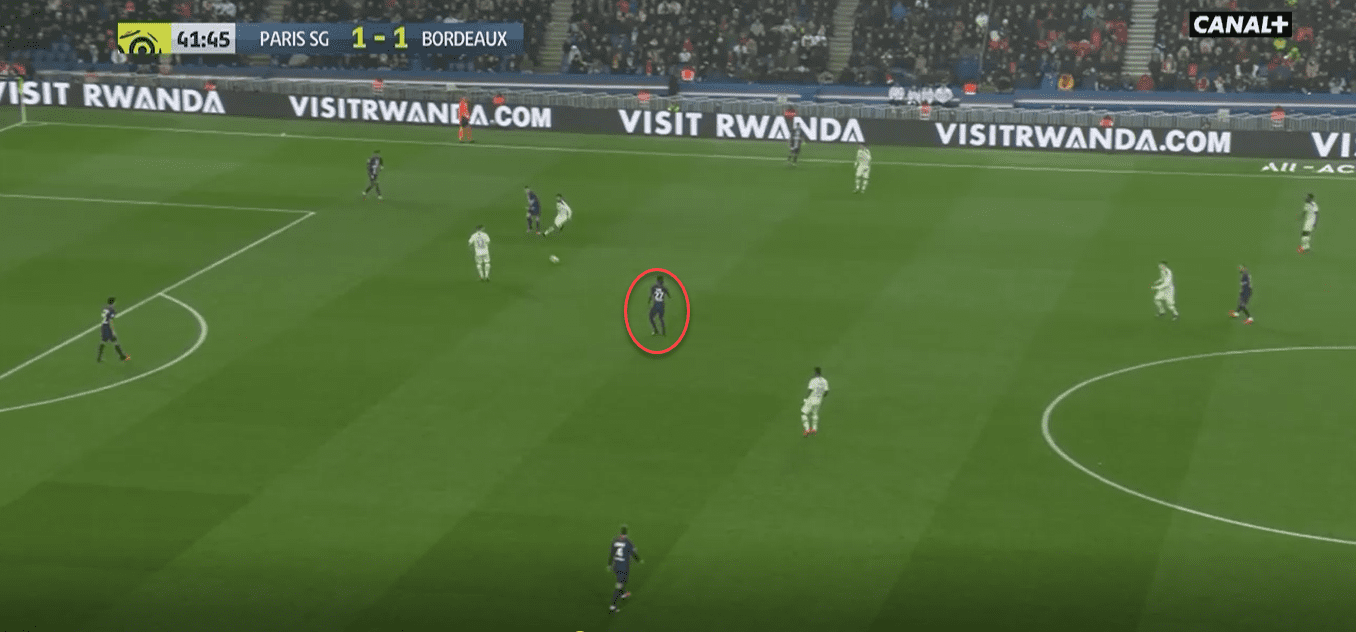
The danger in becoming stretched in this way was that once PSG broke through midfield, they could easily find the ball to players like Mbappe in 1v1 match-ups.
Another problem for Bordeaux was the footwork of some of the players in their backline. Kwateng especially struggled, and on various occasions, he was caught flat as shown below.
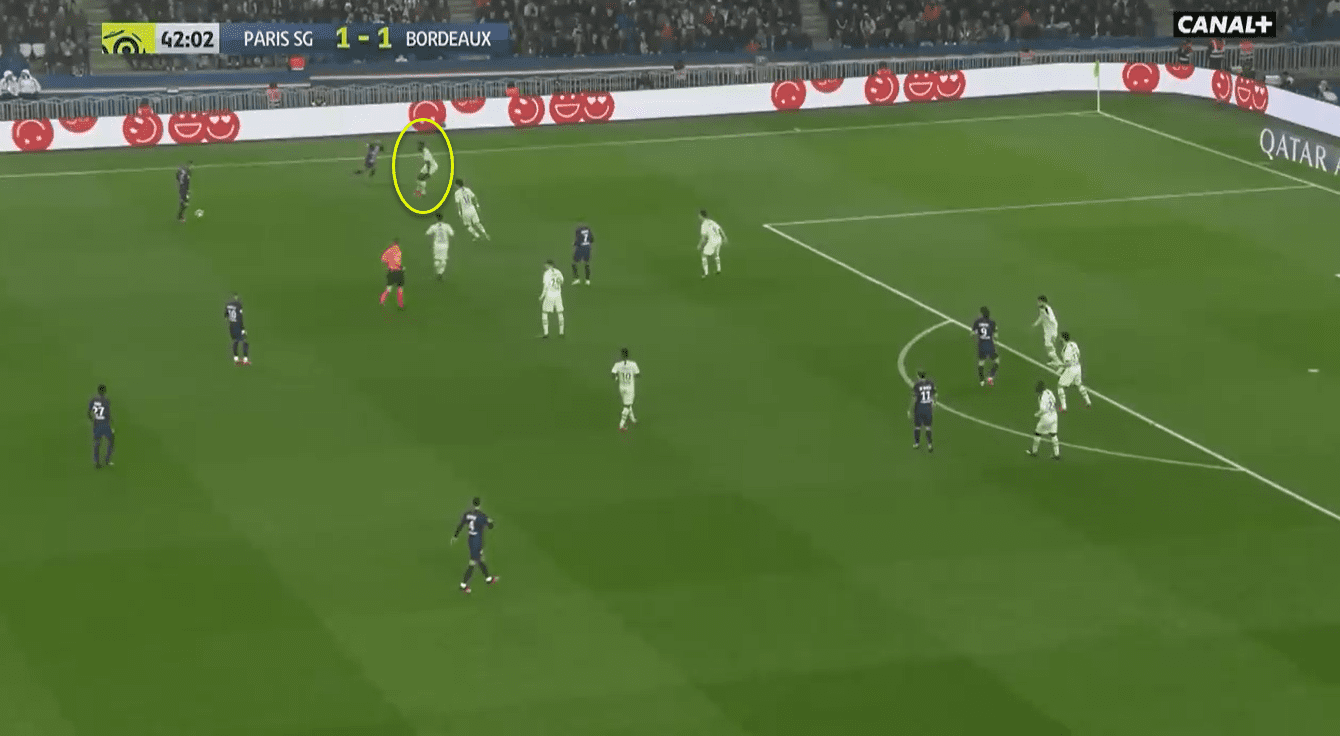
Such footwork is criminal against a team that boasts players with the pace of Mbappé, and PSG were, therefore, able to create a handful of opportunities down the flanks that should have been buried.
A final area in which Bordeaux struggled defensively was their ability to defend crosses. Specifically, they had trouble reading the cue for when a cross would be played. This was especially problematic because after backing down the Bordeaux defence, PSG often employed in-swinging crosses from players like Di María to find a way through. Several times when these crosses came in, Bordeaux were caught flat and did not properly track the runners in behind as illustrated below, and this is how PSG scored their first two goals of the game.
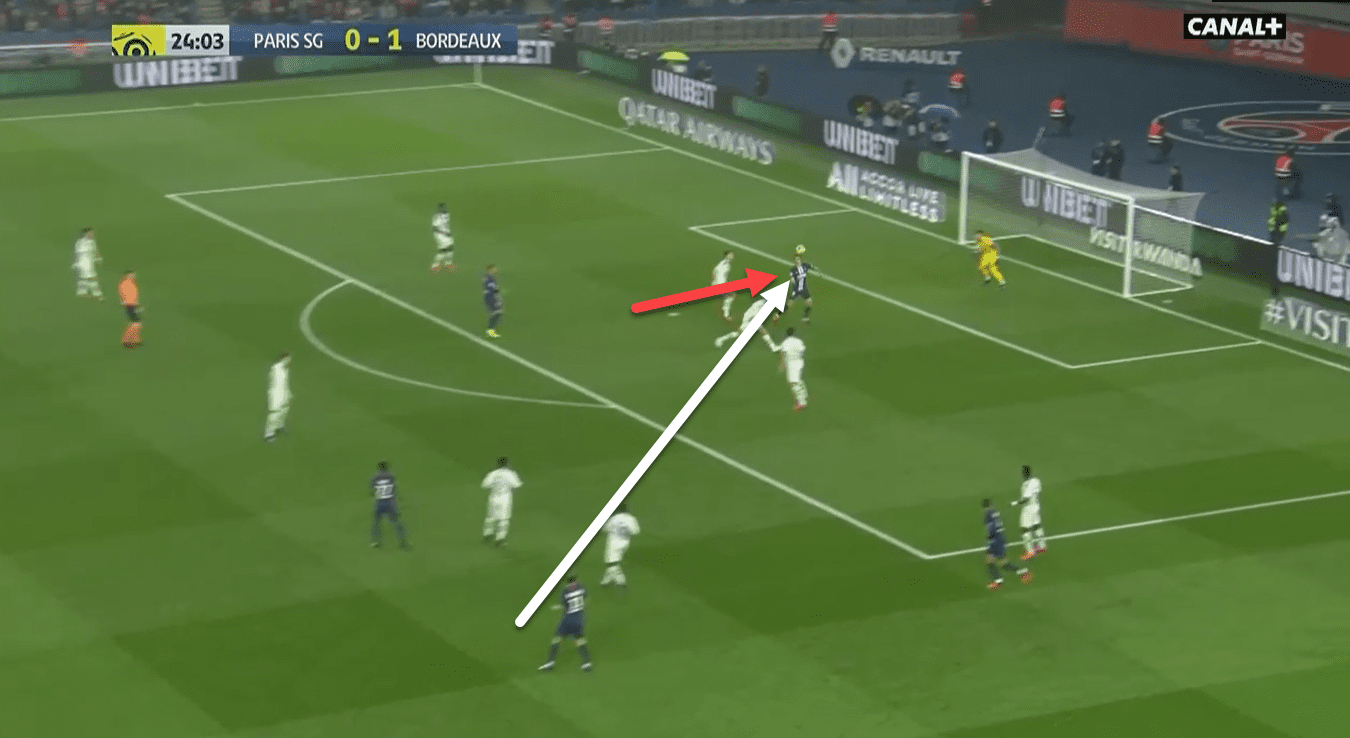
Bordeaux’s second-half adjustment
After a first half in which Bordeaux was carved open and mounted little attacking threat, Paulo Sousa decided to switch Bordeaux into a 4-5-1 formation with one holding midfielder. This adjustment was largely successful for the opening fifteen minutes of the first half because it reduced the space in midfield, allowed Bordeaux to be more compact, and positioned one player between the lines who could help deal with Neymar and Di María drifting centrally. As a result, upon receiving between the lines, PSG found themselves more often in situations like the one shown below in which Mbappé and Neymar were crowded out.
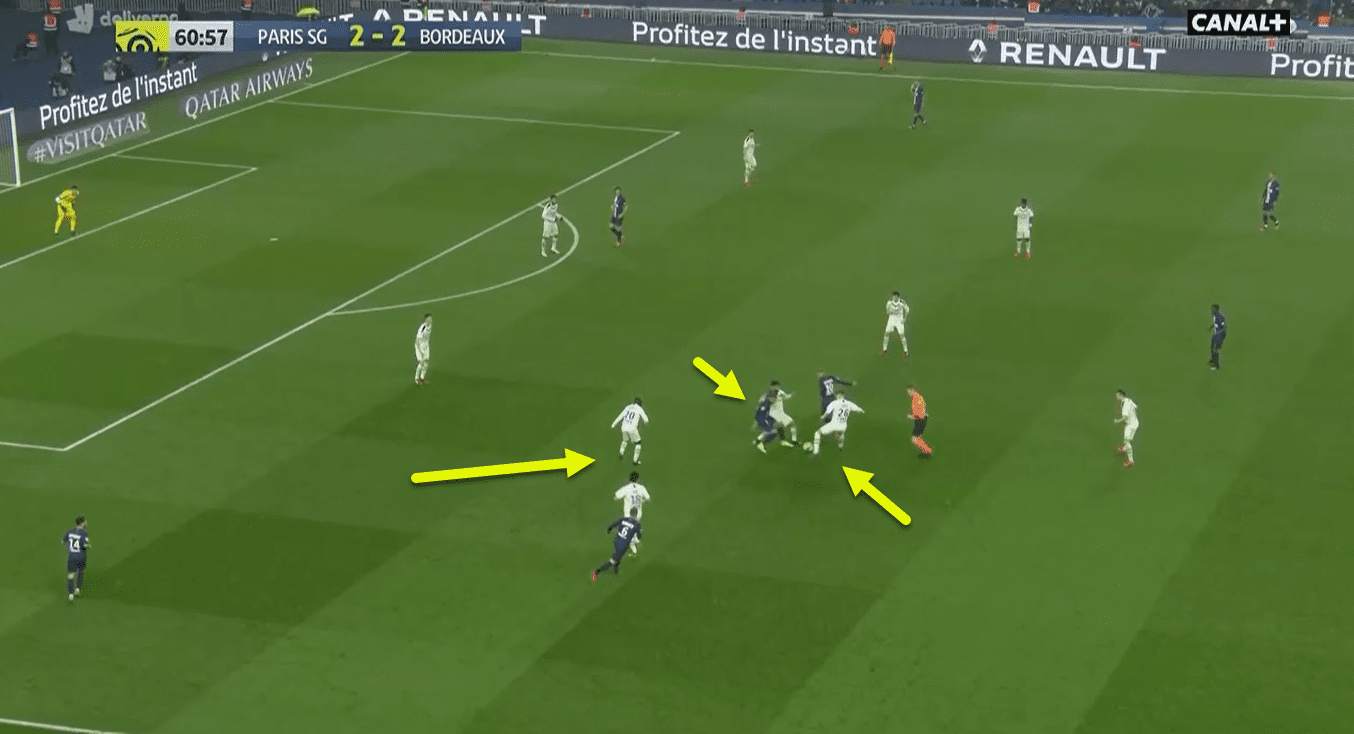
This improvement in Bordeaux’s midfield compactness was then the springboard for attacking forays into PSG’s half, and this period saw Bordeaux produce some of their best chances of the match. Additionally, Mbappé became increasingly frustrated and, rather than staying disciplined in his high position to pin back the Bordeaux backline and create space for others, he drifted onto the right flank. Instead of improving PSG’s attack, this played into Bordeaux’s hands because it left Cavani isolated.
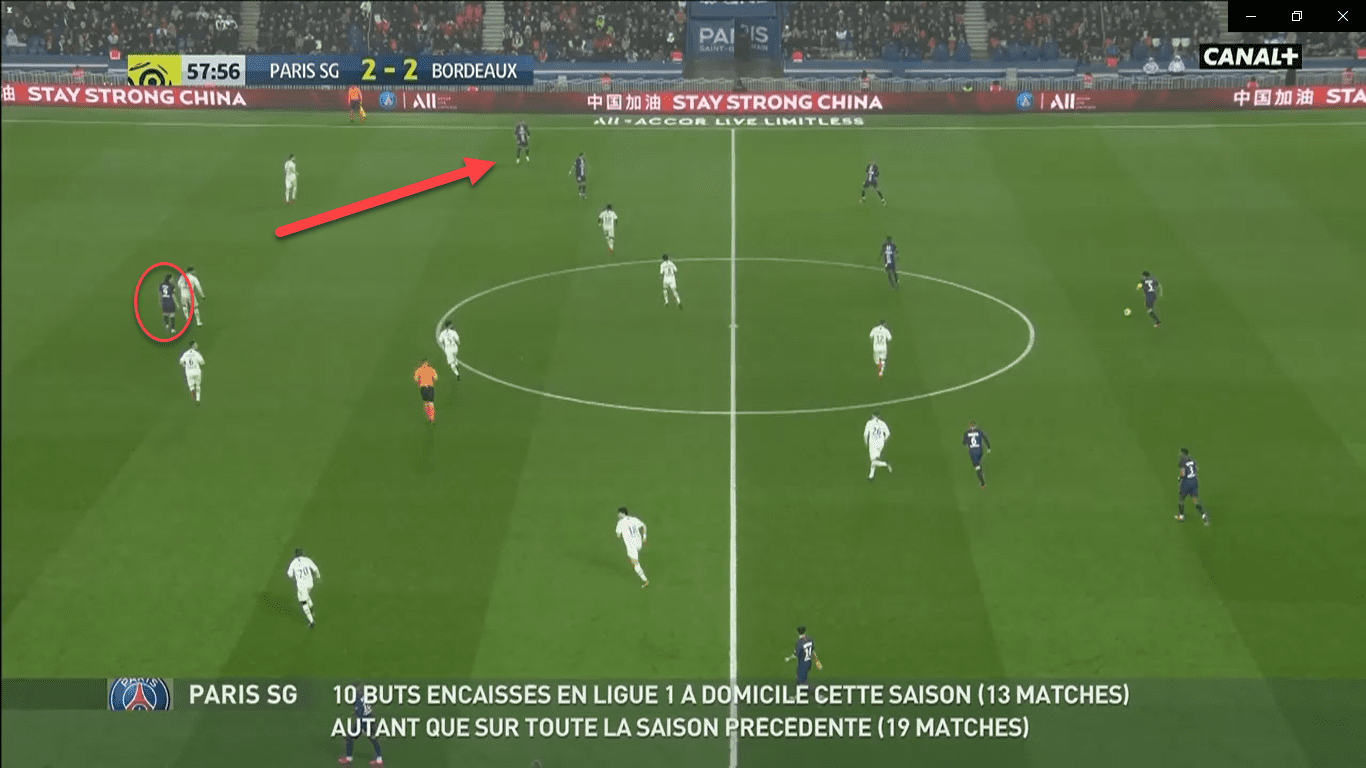
PSG’s resurgence
After being disrupted for nearly 20 minutes, PSG were eventually able to regain their stranglehold on the match. More than anything else, this was the result of a rededication to what had made them successful in the first half. For instance, Mbappé rejoined Cavani in a strike partnership, which again opened the space between the lines. As shown below, Neymar, in particular, took advantage of these pockets and began wreaking havoc as he ran at the Bordeaux backline.
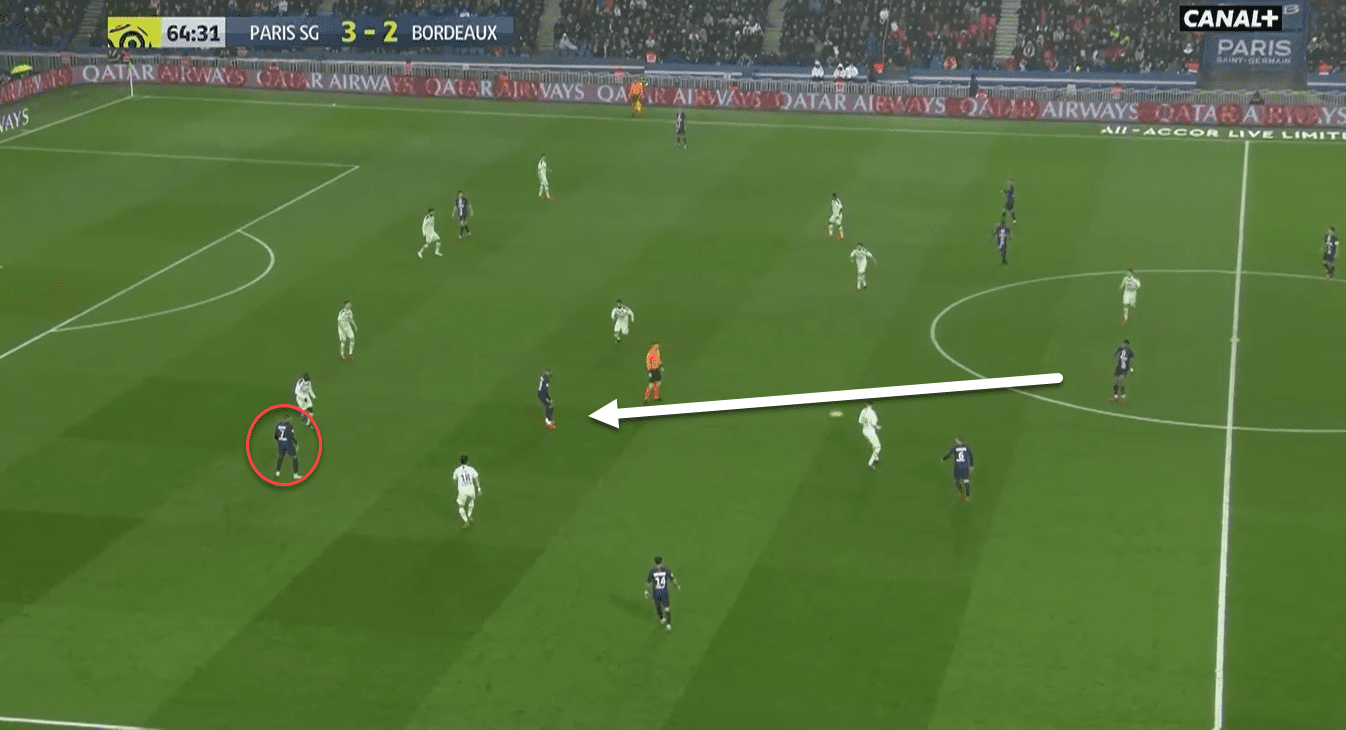
On top of that, PSG recommitted themselves to aggressive counter-pressing. The first fifteen minutes of the second half saw PSG achieve their lowest totals in pressing intensity and recoveries per minute, but they regained their former standard in minutes 60-75. And notably, it was counter-pressing that saw PSG smother Bordeaux in transition to set up their fourth goal.
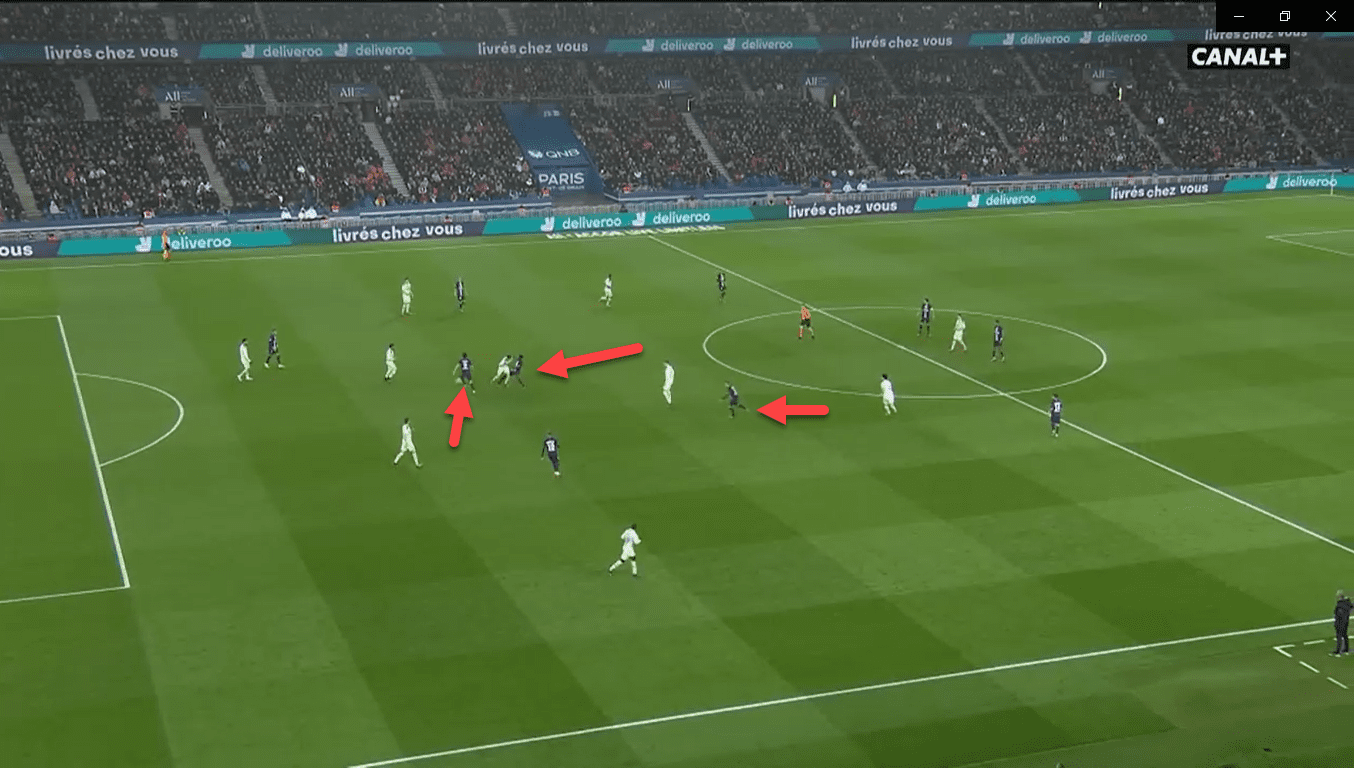
Conclusion
PSG continued to stay largely in command for the remainder of the match outside of a wonder strike from Ruben Pardo, and the game finished more comfortably for the Parisians than the 4-3 scoreline suggests. But despite a PSG performance that was stellar in many regards, there are still many concerns for the French champions. For instance, Neymar was needlessly red-carded in stoppage time, which suggests the Brasilian still desperately lacks in maturity. What’s more, PSG’s first two goals were more akin to those that would be conceded by a second division side than a team of PSG’s calibre. As a result, it appears there is still much work to be done if PSG want to become Europe’s strongest side.






Comments